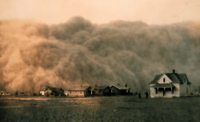
Photo from wikipedia
Abstract Dust emitted from the surface of arid and semi-arid regions is a natural source of coarse particulate matter (PM) in the atmosphere. Long-distance transport episodes of desert dust to… Click to show full abstract
Abstract Dust emitted from the surface of arid and semi-arid regions is a natural source of coarse particulate matter (PM) in the atmosphere. Long-distance transport episodes of desert dust to Europe can have a large impact on air quality, and high atmospheric concentrations of particulate matter can also affect the routine sampling and analysis of airborne pollen grains and fungal spores. Here, I examine two desert dust episodes recorded in Novi Sad, Serbia, and discuss the possible implications such events could have on the continuous outdoor aerobiological monitoring. Continuous sampling was conducted using the traditional Hirst-type volumetric trap, state-of-the-art Plair SA Rapid-E automatic sampler, and the GRIMM EDM 180 optical particle sizer and counter. Large quantities of airborne particles collected during the dust events densely covered the impaction surface in samples collected using the Hirst trap, and made identification of biological particles challenging. Such airborne particles can also have an impact of the life of the 337 nm laser used in the Rapid-E. Nevertheless, significant correlations between the hourly particle concentrations (Rapid-E) and the mass concentrations (GRIMM EDM 180) suggest that the automatic aerobiological networks could also be mobilized for providing additional data points for the validation and assimilation of dust dispersion models.
Journal Title: Aeolian Research
Year Published: 2020
Link to full text (if available)
Share on Social Media: Sign Up to like & get
recommendations!